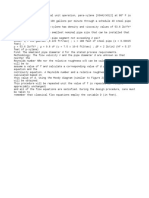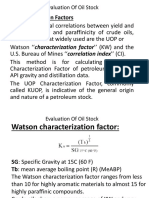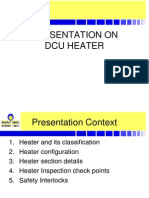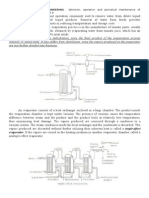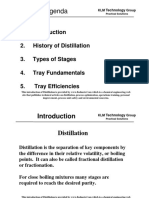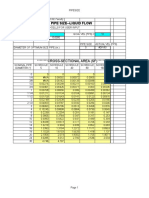Distillation Column
Uploaded by
genergiaDistillation Column
Uploaded by
genergiaDistillation:
Process in which a liquid or vapour mixture
of two or more substances is separated into
its component fractions of desired purity, by
the application and removal of heat
CHOICE BETWEEN PLATE AND
PACKED COLUMN
The choice between use of tray column or a
packed column for a given mass transfer
operation should, theoretically, be based on a
detail cost analysis for the two types of
contactors. However, the decision can be made
on the basis of a qualitative analysis of relative
advantages and disadvantages, eliminating the
need for a detailed cost comparison.
Which are as follows
Liquid dispersion difficulties
Capable of handling wide ranges
liquid rates
Cleaning.
Non-foaming systems
Periodic cleaning
weight of the column
Design information
Inter stage cooling
Temperature change
Diameters
As my system is non foaming and
diameter calculated is larger than 0.67 m
so I am going to use Tray column.
Also as average temperature calculated
for my distillation column is higher that is
approximately equal to 98
o
c. So I prefer
Tray column.
PLATE CONTACTORS:
Cross flow plate are the most commonly
used plate contactor in distillation. In which
liquid flows downward and vapours flow
upward. The liquid move from plate to plate
via down comer. A certain level of liquid is
maintained on the plates by weir.
Three basic types of cross flow
trays used are
Sieve Plate (Perforated Plate)
Bubble Cap Plates
Valve plates (floating cap plates)
Selection of Trays:
I prefer Sieve Plate because:
Pressure drop is low as compared to bubble
cap trays
Their fundamentals are well established,
entailing low risk.
The trays are low in cost relative to many other
types of trays.
They can easily handle wide variations in flow
rates.
They are lighter in weight. It is easier and
cheaper to install.
Maintenance cost is reduced due to the ease of
cleaning.
Sieve Tray
Label Diagram (sieve tray)
Major Beam
Plate Support
Ring
Downcomer
And
Weir
Calming
Zone
Man
Way
FACTORS AFFECTING DISTILLATION
COLUMN OPERATION
Adverse vapour flow conditions can cause:
Blowing
Coning
Dumping
Raining
Weeping
Flooding
FEED
REFLUX
DRUM
(1) Methyl Iodide = 0.074
(2) Acetic Acid = 0.65
(3)Methyl Acetate = 0.215
(4) Water = 0.065
(1) Methyl Iodide
= 0.212
(2) Acetic Acid =
0.0005
(3)Methyl
Acetate = 0.62
(4) Water = 0.167
Condenser
Pump
Reboiler
FEED
(1) Methyl Iodide = 0.07
(2) Acetic Acid = 0.65
(3)MethylAcetate=0.22
(4) Water = 0.065
REFLUX DRUM
(1) Methyl Iodide = 0.21
(2) Acetic Acid = 0.0005
(3)Methyl Acetate = 0.62
(4) Water = 0.17
(1)Acetic Acid = 0.99
(2)Water = 0.01
FLOW SHEET
From Material Balance:
Heavy Key Component = Acetic Acid
Light Key Component = Water
Component Feed
Fraction
x
f
Bottom
Fraction
x
b
Top
Fraction
x
d
(1) Methyl
Iodide
0.07
0
0.21
(2) Acetic
Acid
0.65
0.99 0.0005
(3) Methyl
Acetate
0.22
0
0.62
(4) Water
0.07
0.01
0.17
DESIGNING STEPS OF
DISTILLATION COLUMN
Calculation of Minimum number of stages.N
min
Calculation of Minimum Reflux Ratio R
m
.
Calculation of Actual Reflux Ratio.
Calculation of theoretical number of stages.
Calculation of actual number of stages.
Calculation of diameter of the column.
Calculation of weeping point, entrainment.
Calculation of pressure drop.
Calculation of the height of the column.
Calculation of Minimum no. of Plates:
The minimum no. of stages N
min
is obtained
from Fenske equation which is,
N
min
= LN[(x
LK
/x
HK
)
D
(x
HK
/x
LK
)
B
]
LN (
LK
/
HK
)
average
Average geometric relative volatility = 1.53
So,
N
min
= 24
Calculation of Minimum Reflux
Ratio R
m
:
Using Underwood equations
As feed is entering as saturated vapors so,
q = 0
By trial, u = 1.68
Using equation of minimum reflux ratio,
Putting all values we get,
R
m
= 4.154
1 R
m
B
DB B
A
DA A
+ =
x x
q 1
B
fB B
A
fA A
=
x x
Actual Reflux Ratio:
The rule of thumb is:
R = (1.2 ------- 1.5) R
min
R = 1.5 R
min
R = 6.23
Theoretical no. of Plates:
Gilliland related the number of
equilibrium stages and the minimum
reflux ratio and the no. of
equilibrium stages with a plot that
was transformed by Eduljee into the
relation;
From which the theoretical no. of stages
to be,
N= 39
(
|
.
|
\
|
+
=
+
566 . 0
min min
1
1 75 . 0
1 R
R R
N
N N
Calculation of actual number of
stages:
Overall Tray Efficiency:
(
|
|
.
|
\
|
=
avg avg o
E o . log 5 . 32 51
avg
=average relative volatility of light key component
=1.75
avg
= molar average liquid viscosity of feed evaluated at
average temperature of column
Average temperature of column =(118+71)/2
= 95
o
C
Feed viscosity at average temperature =
avg
= 0.39 mNs/m
2
So,
E
o
= 56.60%
So,
No. of actual trays = 39/0.566 = 68
Location of feed Plate:
The Kirk bride method is used to determine the
ratio of trays above and below the feed point.
From which,
Number of Plates above the feed tray = ND = 47
Number of Plates below the feed tray = NB = 21
( )
( )
( )
(
|
.
|
\
|
|
.
|
\
|
=
|
.
|
\
|
2
log 206 . log
D HK
B LK
LK
HK
B
D
x
x
x
x
D
B
N
N
Determination of the
Column Diameter:
Flow Parameter:
F
LV
= Liquid Vapor Factor = 0.056
0.5
L
v
n
n
LV
V
L
F
|
|
.
|
\
|
|
|
.
|
\
|
=
Capacity Parameter:
Assumed tray spacing = 18 inch (0.5 m)
From Fig (15-5) Plant Design and Economics for
Chemical Engineering, sieve tray flooding capacity,
C
sb
= 0.0760 m/Sec
Surface tension of Mixture = = 18.35 dynes/Cm
V
nf
=1.67 m/sec
Assume 90% of flooding then
V
n
=0.9V
nf
So, actual vapor velocity,
V
n
=1.51 m/sec
5 . 0
2 . 0
20
|
|
.
|
\
|
|
.
|
\
|
=
v
v l
C V
sb nf
o
Net column area used in separation is
A
n
= m
v
/V
n
Volumetric flow rate of vapors = m
v
m
v
= (mass vapor flow rate /(3600)
vapor density)
m
v
= 2.1184m
3
/sec
Now, net area A
n
= m
v
/V
n
= 1.41m
2
Assume that downcommer occupies 15% of
cross sectional Area (A
c
) of column thus:
A
c
= A
n
+ A
d
Where, A
d
= downcommer area
A
c
= A
n
+ 0.15(A
c
)
A
c
= A
n
/ 0.85
A
c
=1.65 m
2
So Diameter of Column Is
A
c
=(/4)D
2
D = (4A
c
/)
D = 1.45 meter = 5ft
(based upon bottom conditions)
Liquid flow arrangement:
In order to find liquid flow arrangement first
find maximum liquid volumetric flow rate
So liquid flow rate =
(Liquid mass rate)/ (3600) (Liquid density)
Max Liquid Rate Is At the bottom of column
so using "L
m
" values
So Maximum liquid flow rate = 0.005 m
3
/sec
So from fig11.28 Coulson & Richardson 6th
volume 3rd edition cross flow single pass
plate is selected
Provisional Plate Design:
Column Diameter D
c
= 1.4513 m
Column Cross-sectional Area(A
c
)= 1.65 m
2
Down comer area Ad = 0.15A
c
= 0.25 m
2
Net Area (A
n
) = A
c
- A
d
=1.41 m
2
Active area A
a
=A
c
-2A
d
= 1.16 m
2
Hole area A
h
take 10% A
a
= 0.1 1.16
=0.0462 m
2
Weir length
Ad / Ac = 0.248 / 1.654 = 0.15
From figure 11.31 Coulson &
Richardson 6th volume 3rd
edition
L
w
/ dc = 0.80
L
w
= 1.452*0.80
= 0.733 m
Weir length should be 60 to 85% of
column diameter which is satisfactory
Take weir height, h
w
= 50 mm
Hole diameter, d
h
= 5 mm
Plate thickness = 5 mm
Check Weeping:
where U
min
is the minimum design vapor
velocity.
The vapor velocity at weeping point is
the minimum velocity for the stable
operation.
In order to have K
2
value from fig11.30
Coulson & Richardson 6th volume 3rd edition we
have to 1st find h
ow
(depth of the crest
of liquid over the weir)
where h
ow
is calculated by following
formula:
( )
( )
( )
2 / 1
2
min
4 . 25 9 . 0
v
d K
U
h
h
ow
=750[(L
m
/l
w
*)
2/3
]
Maximum liquid rate L
m
= 4.7 kg/sec
Minimum Liquid Rate At 70% turn down ratio
= 3.3Kg/sec
At Maximum rate ( h
ow
)= 20 mm Liquid
At Minimum rate (h
ow
) = 16 mm Liquid
h
w
+ h
ow
= 50 + 16 = 66 mm Liquid
from fig 11.30, Coulson and Richardson Vol.6
K
2
= 30.50
So,
U
(min)
= 9 m/sec
Now maximum volumetric flow rate
(vapors)
Base = 2.12 m
3
/sec
Top = 1.14 m
3
/sec
At 70% turn down ratio
Actual minimum vapor velocity
=minimum vapor rate / A
h
= 12.81 m/sec
So minimum vapor rate will be well
above the weep point.
Plate Pressure Drop (P.D):
Consist of dry plate P.D (orifice loss), P.D
due to static head of liquid and residual
P.D (bubbles formation result in energy
loss)
Dry Plate Drop:
Max. Vapor velocity through holes (Uh) =
Maximum Volumetric Flow Rate / Hole
Area = 18.30 m/sec
Perforated area Ap (active area) =1.16 m
2
Ah/Ap = 0.100
From fig. 11.34 (Coulson & Richardson
6th volume 3rd edition) for
plate thickness/hole diameter = 1.00
We get, C
o
= 0.84
This equation is derived for orifice
meter pressure drop.
h
d
= 48 mm Liquid
Residual Head (h
r
):
hr = (12.5*10
3
/
L
)
= 13.3 mm Liquid
L
V
o
h
d
C
U
h
51
(
(
=
So,
Total pressure drop
=48+(50+20)+13.32
h
t
= 131.35 mm liquid
Total column pressure drop Pa, (N/m
2
)
= (9.81*10
-3
) h
t
L
N
= 82771.6 Pa = 82 kPa
r ow w d t
h h h h h + + + = ) (
Down comer Liquid Backup:
Caused by Pressure Drop over the plate and resistance to
flow in the downcomer it self.
h
b
= (h
w
+ h
ow
) + h
t
+ h
dc
The main resistance to flow in downcomer will be
caused by constriction in the downcomer outlet, and
head loss in the down comer can be estimated using the
equation given as,
where L
wd
is the liquid flow rate in downcomer, kg/sec
and Aap is the clearance area under the downcomer, m
2
A
ap
=h
ap
L
w
2
166
(
(
=
ap L
wd
dc
A
l
h
Where h
ap
the height of bottom edge of
apron above the plate.
h
ap
= h
w
(5 to 10 mm)
h
ap
= 40 mm
so,
Area under apron A
ap
= 0.05 m
2
As this is less than area of downcomer A
d
so
using A
ap
values in above formula.
So,
h
dc
= 1.95 mm
As a result,
h
b
= 203.24 mm
= 0.203 m
h
b
< (Tray spacing + weir height)
0.20 < 0.25
So tray spacing is acceptable
Check Residence Time:
Sufficient residence time should be allowed
in the downcomer for the entrained vapors
to disengage from liquid stream to prevent
aerated liquid being carried under the
downcomer.
t
r
=A
d
h
bc
L
/L
(max)
t
r
= 10 sec
It should be > 3 sec. so, result is satisfactory
Check Entrainment:
(u
n
) actual velocity = (maximum volumetric
flow rate at base V
m
/ net area A
n
)
(u
n
) actual velocity = 1.51 m/sec
Velocity at flooding condition U
f
= 1.67 m/sec
So Percent flooding =u
n
/ u
f
= 0.90 = 90%
Liquid flow factor F
LV
= 0.056
From fig. 11.29 Coulson &
Richardson 6th volume 3rd edition
fractional entrainment can be found
out.
Fractional entrainment () =
0.0750
Well below the upper limit of () which
is 0.1. Below this the effect of
entrainment on efficiency is small.
No of Holes:
Area of 1 Hole = (/4) D
hole
2
= 0.00002 m
2
Area of N Holes = 0.1158 m
2
So,
Number OF Holes = 5900
Height of Distillation Column
Height of column H
c
= (N
act
-1) H
s
+ H+ plates
thickness
No. of plates = 68
Tray spacing H
s
= 0.50 m
H= 0.5 meter each for liquid hold up and
vapor disengagement
H=1 m
Total thickness of trays = 0.005*68 = 0.34 m
So,
Height of column = (68-1)*0.50+ 1+0.34
= 35 meters
1.45m height=35m
Hole
diameter=5mm
No. of
holes=5900
h
ap
=40 mm
h
W
=50 mm
h
ow
=Weir crust
Plate Specifications
Specification Sheet Of Distillation Column:
Identification:
Item Distillation column
No. required 1
Tray type Sieve tray
Function: Separation of Acetic Acid from iodo methane
and Reaction by products.
Operation: Continuous
Feed
Top
Bottom
Amount
4755 Kg/hr
1968 Kg/hr
2786 Kg/hr
Composition
of
Acetic Acid
0.64
0.005
0.99
Temp.
119
o
C
71
o
C
118
o
C
Material handled:
Design data:
No. of tray= 68
Pressure = 101.325 Kpa
Height of column = 35 m
Diameter of column=1.45m
Hole size = 5 mm
Pressure drop per
tray=1.2 Kpa
Tray thickness = 5 mm
Active holes = 5900
Weir height = 50 mm
Weir length = 1 m
Reflux ratio = 6.23
Tray spacing =0.5 m
Active area = 1.16 m
2
Percent Flooding =90%
Entrainment = 0.075
References
Coulson & Richardson 6th volume 3rd
edition
Plant Design and Economics for
Chemical Engineering
Coulson & Richardson 2th volume 5th
edition
Perrys Chemical engineers hand book
The End
You might also like
- Stripping Column: Haldia Institute of TechnologyNo ratings yetStripping Column: Haldia Institute of Technology14 pages
- Simulink Development of Single Effect Evaporator Using MatlabNo ratings yetSimulink Development of Single Effect Evaporator Using Matlab12 pages
- Design of Fixed Bed Adsorption Columns: CENG 4710 Environmental ControlNo ratings yetDesign of Fixed Bed Adsorption Columns: CENG 4710 Environmental Control17 pages
- Fundamentals of Refining Products and Properties100% (1)Fundamentals of Refining Products and Properties46 pages
- Characterization Factors: Evaluation of Oil StockNo ratings yetCharacterization Factors: Evaluation of Oil Stock65 pages
- The Transportation Lag: X (T) X (T-X (S) X(S)No ratings yetThe Transportation Lag: X (T) X (T-X (S) X(S)9 pages
- Interview Questions For Chemical EngineeringNo ratings yetInterview Questions For Chemical Engineering6 pages
- CH 5 - Fractionating Column (Atm Vac) 2018 BNo ratings yetCH 5 - Fractionating Column (Atm Vac) 2018 B193 pages
- Chapter No.3 Material Balance: 3.1 Fluidized Bed ReactorNo ratings yetChapter No.3 Material Balance: 3.1 Fluidized Bed Reactor14 pages
- Optimal Design and Operation of Isomerization ProcessNo ratings yetOptimal Design and Operation of Isomerization Process184 pages
- Problem Solving & Troubleshooting in Process OperationsNo ratings yetProblem Solving & Troubleshooting in Process Operations6 pages
- Distillation Column Selection, Sizing and Troubleshooting, Kolmetz Handbook of Process Equipment DesignNo ratings yetDistillation Column Selection, Sizing and Troubleshooting, Kolmetz Handbook of Process Equipment Design24 pages
- Absorber Design:: Theoretical BackgroundNo ratings yetAbsorber Design:: Theoretical Background15 pages
- Comparison of Gas Absorption and Distillation Unit Operations100% (2)Comparison of Gas Absorption and Distillation Unit Operations2 pages
- 2017.08.28 - Gas - Liquid Contacting Equipments PDFNo ratings yet2017.08.28 - Gas - Liquid Contacting Equipments PDF37 pages
- Presentation On: Fundamentals of Refinery ProcessesNo ratings yetPresentation On: Fundamentals of Refinery Processes110 pages
- 002 Lecture OverView Refinery Lecture B W 002100% (1)002 Lecture OverView Refinery Lecture B W 00287 pages
- Optimum Pipe Size - Liquid Flow: CROSS-SECTIONAL AREA (SF)No ratings yetOptimum Pipe Size - Liquid Flow: CROSS-SECTIONAL AREA (SF)1 page
- Input Form: Input For Venture Guidance AppraisalNo ratings yetInput Form: Input For Venture Guidance Appraisal7 pages
- Simulink Development of Single Effect Evaporator Using MatlabSimulink Development of Single Effect Evaporator Using Matlab
- Design of Fixed Bed Adsorption Columns: CENG 4710 Environmental ControlDesign of Fixed Bed Adsorption Columns: CENG 4710 Environmental Control
- Chapter No.3 Material Balance: 3.1 Fluidized Bed ReactorChapter No.3 Material Balance: 3.1 Fluidized Bed Reactor
- Optimal Design and Operation of Isomerization ProcessOptimal Design and Operation of Isomerization Process
- Problem Solving & Troubleshooting in Process OperationsProblem Solving & Troubleshooting in Process Operations
- Distillation Column Selection, Sizing and Troubleshooting, Kolmetz Handbook of Process Equipment DesignDistillation Column Selection, Sizing and Troubleshooting, Kolmetz Handbook of Process Equipment Design
- Comparison of Gas Absorption and Distillation Unit OperationsComparison of Gas Absorption and Distillation Unit Operations
- 2017.08.28 - Gas - Liquid Contacting Equipments PDF2017.08.28 - Gas - Liquid Contacting Equipments PDF
- Presentation On: Fundamentals of Refinery ProcessesPresentation On: Fundamentals of Refinery Processes
- Optimum Pipe Size - Liquid Flow: CROSS-SECTIONAL AREA (SF)Optimum Pipe Size - Liquid Flow: CROSS-SECTIONAL AREA (SF)













